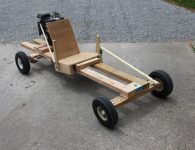

They say things are bigger in Texas, and it seems that goes for drones as well as pickup trucks and cowboy hats. At least, if Fort Worth-based Bell’s new, autonomous cargo carrier is any indicator.
The four-motor, vertical-lift electric UAV is one of the largest commercial cargo drone projects to reach the skies. It stands nearly 6 feet tall and 9 feet wide on the ground (it rests on its tail before transitioning to horizontal flight after liftoff). It weighs 300 pounds and can carry an additional 70 pounds of cargo, slung in an aerodynamic pod between its two wings. That all-important stat gives it the name APT 70, the letters standing for “autonomous pod transport.” It first started flying in December via remote control, and in the past three weeks began fully autonomous flight, Bell announced this week.
The helicopter manufacturer developed the APT 70 for NASA’s drone integration program, formally known as the Systems Integration and Operationalization demonstration activity. In that effort, it’s primarily intended to demonstrate commercial drone missions in public airspace, as well as their autonomous behavior beyond an operator’s line of sight.
Bell’s APT 70 cargo drone has been flying via remote control in December, and started autonomous operations a few weeks ago.
Bell
But Bell thinks it has found a sweet spot with this configuration in terms of payload, range, and usability that will appeal to a wide array of customers. “When most people think of cargo drones they imagine these small and cute little things,” says Scott Drennan, Bell’s vice president in charge of engineering innovation, which includes drone drone development as well as its larger air taxi initiative. “But when you get the payloads that most companies actually find useful, it gets to be a much larger aircraft.”
Each of the APT 70’s four motors sits on a pylon attached to its own narrow fuselage, with horizontal and vertical stabilizers at the rear. These act as the legs and feet for the aircraft while on the ground. They power four blades, which provide vertical thrust at takeoff. The aircraft then pitches forward for horizontal flight, with a pair of stacked wings (a bit like a biplane) generating lift and enabling higher speeds. It can fly at 100 mph, though will typically cruise at 75, and cover up to 35 miles on a single charge while carrying its maximum payload. Altering the relative speeds of the rotors allows maneuverability comparable to that of a nimble quadcopter drone.
The large drone is a successor to a smaller demonstrator, the APT 20, that Bell has been flying for several years. Though both aircraft first flew as remotely piloted systems, their operation was always augmented with autonomous functionality, including the ability for the aircraft to remain stable and in its current flight mode should the pilot release the controls. Now the APT 70 can take off, transition to horizontal flight, fly to a string of waypoints, return to its starting point, and land entirely on its own.
read more at https://www.wired.com/latest by Eric Adams
Tech








